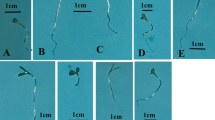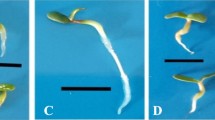Abstract
This research explored the capability of seed priming with the non-thermal plasma to modify reactions of Melissa officinalis, an important medicinal plant, to zinc oxide (nZnO) or selenium (nSe) nanoparticles. The germinating seeds were primed with the plasma (0.84Wcm−2 surface power densities) under different durations (0, 50, 90, and 120 s); after that the primed seeds were cultured in petri dish containing Hoagland nutrient solution manipulated with various concentrations of nSe (0, 2, 5, 10, and 20 mgl−1) or nZnO (0, 50, and 250 mgl−1). The plasma treatments not only improved growth-related characteristics (stem length, root length, and leaf wide) and biomass accumulation but also toxicity signs of nSe (5, 10, and 20 mgl−1) were partly mitigated by the plasma priming. Interestingly, the plasma treatments induced peroxidase activity about 46%. Similarly, inductions in the activity of phenylalanine ammonia lyase were recorded in the plasma-primed seedlings. The correlations between the evaluated traits were found to be significant. Taken collectively, it could be exploited for delivering a novel tool regarding seed priming, biofortification, and seed/seedling-derived foods.







Similar content being viewed by others
References
Iranbakhsh A, Ghoranneviss M, Oraghi Ardebili Z, Oraghi Ardebili N, Hesami Tackallou S, Nikmaram H (2017) Non-thermal plasma modified growth and physiology in Triticum aestivum via generated signaling molecules and UV radiation. Biol Plant 61:702–708
Bourke P, Ziuzina D, Boehm D, Cullen P, Keener K (2018) The potential of cold plasma for safe and sustainable food production. Trends Biotech. https://doi.org/10.1016/j.tibtech.2017.11.001
Iranbakhsh A, Ardebili NO, Ardebili ZO, Shafaati M, Ghoranneviss M (2018) Non-thermal plasma induced expression of heat shock factor A4A and improved wheat (Triticum aestivum L.) growth and resistance against salt stress. Plasma Chem Plasma Process 38(1):29–44
Sera B, Sery M, Gavril B, Gajdova I (2017) Seed germination and early growth responses to seed pre-treatment by non-thermal plasma in hemp cultivars (Cannabis sativa L.). Plasma Chem Plasma Process 37:207–221
Iranbakhsh A, Ardebili ZO, Ardebili NO, Ghoranneviss M, Safari N (2018) Cold plasma relieved toxicity signs of nano zinc oxide in Capsicum annuum cayenne via modifying growth, differentiation, and physiology. Acta Physiol Plant 40(8):154
Bußler S, Herppich WB, Neugart S, Schreiner M, Ehlbeck J, Rohn S, Schlüter O (2015) Impact of cold atmospheric pressure plasma on physiology and flavonol glycoside profile of peas (Pisum sativum ‘Salamanca’). Food Res Int 76:132–141
Møller I, Jensen P, Hansson A (2007) Oxidative modifications to cellular components in plants. Annu Rev Plant Biol 58:459–481
Jiang J, Lu Y, Li J, Ling L, He X, Shao H, Dong Y (2014) Effect of seed treatment by cold plasma on the resistance of tomato to Ralstonia solanacearum (bacterial wilt). PLoS ONE 9:e97753
Stolárik T, Henselová M, Martinka M, Novák O, Zahoranová A, Černák M (2015) Effect of low-temperature plasma on the structure of seeds, growth and metabolism of endogenous phytohormones in pea (Pisum sativum L.). Plasma Chem Plasma Process 35:659–676
Sadhu S, Thirumdas R, Deshmukh R, Annapure US (2017) Influence of cold plasma on the enzymatic activity in germinating mung beans (Vigna radiate). LWT-food Sci Tech 78:97–104
Ling L, Jiang J, Jiangang L, Minchong S, Xin H, Hanliang S, Yuanhua D (2014) Effects of cold plasma treatment on seed germination and seedling growth of soybean. Sci Rep 4:5859
Safari N, Iranbakhsh A, Oraghi Ardebili Z (2017) Non-thermal plasma modified growth and differentiation process of Capsicum annuum PP805 Godiva in in vitro conditions. Plasma Sci Tech 19:055501
Singh H, Jassal RK, Kang JS, Sandhu SS, Kang H, Grewal K (2015) Seed priming techniques in field crops-a review. Agric Rev 36:251–264
Paparella S, Araújo SS, Rossi G, Wijayasinghe M, Carbonera D, Balestrazzi A (2015) Seed priming: state of the art and new perspectives. Plant Cell Rep 34:1281–1293
Safari M, Ardebili ZO, Iranbakhsh A (2018) Selenium nano-particle induced alterations in expression patterns of heat shock factor A4A (HSFA4A), and high molecular weight glutenin subunit 1Bx (Glu-1Bx) and enhanced nitrate reductase activity in wheat (Triticum aestivum L.). Acta Physiol Plant 40:117
Ardebili NO, Saadatmand S, Niknam V, Khavari-Nejad RA (2014) The alleviating effects of selenium and salicylic acid in salinity exposed soybean. Acta Physiol Plant 36:3199–3205
Ardebili ZO, Oraghi Ardebili N, Jalili S, Safiallah S (2015) The modified qualities of basil plants by selenium and/or ascorbic acid. Turkish J Bot 39:401–407
Puccinelli M, Malorgio F, Rosellini I, Pezzarossa B (2017) Uptake and partitioning of selenium in basil (Ocimum basilicum L.) plants grown in hydroponics. Sci Hort 225:271–276
White PJ, Broadley MR (2009) Biofortification of crops with seven mineral elements often lacking in human diets—iron, zinc, copper, calcium, magnesium, selenium and iodine. New Phytol 182:49–84
Asgari-Targhi G, Iranbakhsh A, Oraghi Ardebili Z (2018) Potential benefits and phytotoxicity of bulk and nano-chitosan on the growth, morphogenesis, physiology, and micropropagation of Capsicum annuum. Plant Physiol Biochem 127:393–402
Hemeda H, Hanaa M, Klein BP (1990) Effects of naturally occurring antioxidants on peroxidase activity of vegetable extracts. J Food Sci 55:184–185
Beaudoin-Eagan LD, Thorpe TD (1985) Tyrosine and phenylalanine ammonia lyase activities during shoot initiation in tobacco callus cultures. Plant Physiol 78:438–441
Sheteiwy MS, An J, Yin M, Jia X, Guan Y, He F, Hu J (2018) Cold plasma treatment and exogenous salicylic acid priming enhances salinity tolerance of Oryza sativa seedlings. Protoplasma 8:1–21
Kyzek S, Holubová Ľ, Medvecká V, Zahoranová A, Ševčovičová A, Gálová E (2017) Genotoxic effect of low temperature plasma treatment on plant seeds. Toxicol Lett 280:S119
Asai S, Ohta K, Yoshioka H (2008) MAPK signaling regulates nitric oxide and NADPH oxidase-dependent oxidative bursts in Nicotiana benthamiana. Plant Cell 20:1390–1406
Clarke A, Desikan R, Hurst RD, Hancock JT, Neill SJ (2000) NO way back: nitric oxide and programmed cell death in Arabidopsis thaliana suspension cultures. Plant J 24:667–677
Huché-Thélier L, Crespel L, Le Gourrierec J, Morel P, Sakr S, Leduc N (2016) Light signaling and plant responses to blue and UV radiations—Perspectives for applications in horticulture. Environ Exp Bot 121:22–38
Tamaoki M (2008) The role of phytohormone signaling in ozone-induced cell death in plants. Plant Signal Behav 3(3):166–174
Samuel MA, Miles GP, Ellis BE (2000) Ozone treatment rapidly activates MAP kinase signalling in plants. Plant J 22(4):367–376
Ahlfors R, Macioszek V, Rudd J, Brosché M, Schlichting R, Scheel D, Kangasjärvi J (2004) Stress hormone independent activation and nuclear translocation of mitogen activated protein kinases in Arabidopsis thaliana during ozone exposure. Plant J 40(4):512–522
Fernández-Marcos M, Sanz L, Lewis DR, Muday GK, Lorenzo O (2011) Nitric oxide causes root apical meristem defects and growth inhibition while reducing PIN-FORMED 1 (PIN1)-dependent acropetal auxin transport. Proc Nat Acad Sci 108(45):18506–18511
Zhou R, Zhou R, Zhang X, Zhuang J, Yang S, Bazaka K, Ostrikov K (2016) Effects of atmospheric-pressure N2, He, Air, and O2 microplasmas on mung bean seed germination and seedling growth. Sci Rep 6:32603
Acknowledgements
Corresponding author specially would like to acknowledge of Plasma Physics Research Center, Science and Research Branch, Islamic Azad University, Tehran, Iran. Authors would like to thank Prof. Mahmood Ghoranneviss, M.Sc. Hamed Nikmaram, M.Sc. Maryam Amini, and M.Sc. Hosseini for their benevolent and professional collaborations in the research procedure.
Author information
Authors and Affiliations
Corresponding author
Ethics declarations
Conflict of interest
Authors declare that there is no conflict of interest.
Rights and permissions
About this article
Cite this article
Babajani, A., Iranbakhsh, A., Oraghi Ardebili, Z. et al. Seed Priming with Non-thermal Plasma Modified Plant Reactions to Selenium or Zinc Oxide Nanoparticles: Cold Plasma as a Novel Emerging Tool for Plant Science. Plasma Chem Plasma Process 39, 21–34 (2019). https://doi.org/10.1007/s11090-018-9934-y
Received:
Accepted:
Published:
Issue Date:
DOI: https://doi.org/10.1007/s11090-018-9934-y




